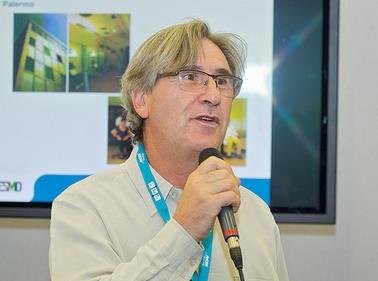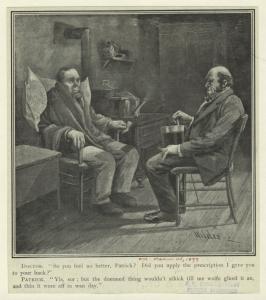With the WHO Executive Board recently adopting the resolution ‘Strengthening of palliative care as a component of integrated treatment within the continuum of care’, which is to be referred to the World Health Assembly for ratification in May, Nathan Cherny puts the current global situation in perspective and lays out the next steps needed in this crucial campaign to end suffering to millions.
By Nathan Cherny
In the curious trail that has been my life thus far, some would say that there was a certain inevitability that I would end up working for cancer patients’ right to access medication for adequate relief of their suffering. As a medical student I suffered terrible cancer-related pain from a thoracotomy to remove lung metastases for testicular cancer. As an oncologist and palliative care physician in the Middle East, my current work allows me to look after both Israeli and Palestinian patients. My profession has also taken me to caring for many “medical tourists” from Eastern Europe as well as foreign workers from Thailand, India, Nepal, and the Philippines. Oh, and I was born on Human Rights Day, 10 December 1958!
I hate pain. I am appalled by the global scope of untreated and unrelieved cancer pain. At the initiative of its Palliative Care Working Group, the European Society for Medical Oncology (ESMO) has taken this on board as a global priority issue. ESMO facilitated the first comprehensive study to evaluate the barriers to pain relief in Europe, which highlighted the distressing situation in many Eastern European counties.

Nathan Cherny
In follow-up, a large collaborative group was formed for an even more ambitious study. The Global Opioid Policy Initiative (GOPI) combined the work and talents of ESMO, the European Association for Palliative Care (EAPC), the Union for International Cancer Control (UICC), the Pain and Policies Study Group (PPSG) of the University of Wisconsin, and the World Health Organization (WHO), and 17 other leading oncology and palliative care societies worldwide.
The GOPI studied opioid availability and accessibility for cancer patients in Africa, Asia, the Middle East, Latin America, and the Caribbean. The results were published in a special supplement of the Annals of Oncology in December 2013. The seven manuscripts in the special issue highlighted the global problem of excessively restrictive regulations regarding the prescribing and dispensing of opioids — ‘catastrophe born out of good intentions’.
In order to prevent abuse and diversion, most patients with genuine need to relieve severe cancer pain cannot access the appropriate medication. Millions of people around the world end their lives racked in pain, harming not only the patients but also their families who bear witness to this torturous tragedy.

On 23 January 2014, the WHO Executive Board adopted a stand-alone resolution on palliative care which will be referred to the World Health Assembly for ratification in May 2014. This is great news for all those campaigning to improve access to medication to end suffering to millions. There is still much to be done on this long, winding road, yet we can still be proud. Thanks to our united efforts and the evidence provided by the GOPI data, our voices are being heard.
Overregulation of opioids is not the only problem impeding global relief of cancer pain. In many places around the world there is major need to: educate clinicians in the assessment and management of pain; educate the public regarding the effectiveness and safety of opioid analgesia in the management of cancer pain; and secure supplies of affordable medications.
The next steps: The GOPI Collaborative Group is now writing to Ministers of Health in the many countries where we have identified major over-regulation with a 10 point plan to help redress the problem, covering education, restrictions, limits, professional standards, monitoring, and prescription.
Tell us what actions you can take to incorporate these next steps in your country. Can you contact your Ministry of Health? What could be inspirational for others to know? We make more noise if we all shout together.
Nathan Cherny was the Chair of the ESMO Palliative Care Working Group since 2008 and has been a member of the working group since its inception in 1999. He was the main driving force in the creation of the ESMO Designated Centre of Integrated Oncology and Palliative Care Programme which was launched in 2003 and last year had its 10th Anniversary. Nathan also wrote the ESMO 2003 Position Paper: ESMO Policy on Supportive and Palliative Care. Watch the Advocacy in Action 2013 video on: Palliative Care & Quality Of Life Care: Redefining Palliative Care.
Opioid availability and accessibility for the relief of cancer pain in Africa, Asia, India, the Middle East, Latin America and the Caribbean: Final Report of the International Collaborative Project was published as an Annals of Oncology supplement in December 2013.
Annals of Oncology is a multidisciplinary journal that publishes articles addressing medical oncology, surgery, radiotherapy, paediatric oncology, basic research and the comprehensive management of patients with malignant diseases. Follow them on Twitter at @Annals_Oncology.
Subscribe to the OUPblog via email or RSS.
Subscribe to only health and medicine articles on the OUPblog via email or RSS.
Image credits: (1) Photo of Nathan Cherny, via ESMO; (2) GOPI banner, via Global Opioid Policy Initiative/ESMO
The post Global Opioid Access: WHO accelerates the pace, but we still need to do more appeared first on OUPblog.

By Richard Hain
One of the things that has always puzzled me is the number of palliative care services that have the word ‘pain’ in the title. Why do we concentrate so much on that one, admittedly unpleasant, symptom? Why ‘Pain and Palliative Care Services’ rather than, for example, ‘Vomiting and Palliative Care Service’ , ‘Dyspnoea and Palliative Care Service’, or even ‘Sadness, Anger, Existential Anguish and Palliative Care Service’?
That’s the problem with trying to describe palliative care. The whole point of palliative care is that it is holistic – a word that has acquired a certain flakiness, but which in reality simply refers to looking at the wholeness of a person, rather than focusing on only one domain (such as physical symptoms), or even one specific symptom (such as pain). But the purpose of a definition, by definition, is to set limits around a concept. There is a sense in which defining something as holistic is a contradiction in terms. Yet that is what we have to do in palliative care, if we are to communicate some sense of the task of caring for children and adults with life-limiting conditions; a sense that encompasses both the idea that it is holistic and that it is specialist (there are some things you need to learn to do to do it well).
The clue to the nature of palliative care is in the name: ‘care’. It is a care whose aim is not cure. In the United Kingdom, we have recently seen the results of misunderstanding what palliative care is all about. As in most countries that are resource-rich (or, at least, would have considered themselves as such before the global recession), the United Kingdom sometimes struggles to avoid the temptation to over-intervene. Even where it is overwhelmingly unlikely that an intervention will help – such as when death is inevitable – we in resource-rich countries can’t help ourselves. Sometimes we have to do something even if we know it is more likely to damage a patient – considered holistically – than it is to help them. That is not because anyone is trying to be cruel, but simply because if you are a doctor faced with a very sick patient, it is hard not to intervene, even when the latter option would truly be the right thing to do.

So, if you want to improve the lives of people who are close to death, one really good way to do it is to offer doctors more support in doing less, and in doing it well. The Liverpool Care Pathway for the Dying Patient (LCP) was designed to do exactly that. Its sole purpose has been to protect dying patients from the pain and indignity of useless interventions around the end of their life. Sadly, holding back on those interventions that will harm people can sometimes look, at least to the untutored eye, very like deliberately killing them. Even some philosophers find it tricky to admit that killing someone is not at all the same thing as refusing to try to prevent their inevitable death. So perhaps it is not surprising to find that, in trying to see who were the baddies here, the Daily Mail crashed clumsily down on the wrong side, screaming that babies were being euthanised using the Liverpool Care Pathway. But it isn’t true.
The Liverpool Care Pathway hasn’t really found its way into children’s care, despite the Daily Mail‘s assertions. That’s because it was designed for adults, mainly with cancer, rather than for children and the much larger range of conditions that can cause their death. There’s nothing wrong with the concept. As in adults, the art and science of palliative care in children is to preserve wellbeing as far as possible, using all the tools at our disposal. To do that often means introducing some interventions – some medication, perhaps, or the opportunity to talk about fears, or the chance to decide where you or your child should die. But improving wellbeing can equally mean withholding interventions that would be likely to cause an overall damage to it. Good paediatric palliative care must mean knowing what procedures to leave out, as well as knowing which ones to introduce. Whatever some moral philosophers say, there is a big difference between actively hastening someone’s death, and not trying fruitlessly to prevent death when to do so would mean making life worse. And whatever the Daily Mail may confidently claim, putting a patient on the Liverpool Care Pathway is not the same as euthanasia. Care pathways are pointers to the best way to avoid careless and harmful over-intervention. Properly used, palliation and pathways do exactly what they say on the tin; they care.
Dr Richard Hain is Consultant and Lead Clinician at the Wales Managed Clinical Network in Paediatric Palliative Care Children’s Hospital, and Visiting Professor at the University of Glamorgan, and Honorary Senior Lecturer at Bangor University. He is co-editor of the Oxford Textbook of Palliative Care for Children, Second Edition (OUP, 2012), with Ann Goldman and Stephen Liben.
Subscribe to the OUPblog via email or RSS.
Subscribe to only health and medicine articles on the OUPblog via email or RSS.
Image credit: Old and young hands photo by SilviaJansen via iStockPhoto.
The post Palliative care: knowing when not to act appeared first on OUPblog.

by Harvey Max Chochinov
A senior colleague recently shared with me the trials of going through a bout of cancer treatment. Physicians are not known to make the best patients and the transition he described was not an easy one. At one point he said, “I wanted to hang a sign over my bed saying ‘P.I.P.’ — Previously Important Person.” To be frank, I was astounded. This man is not only a highly respected and seasoned clinician, but an internationally lauded researcher and medical leader, whose accomplishments have garnered various recognitions and lofty acclaim. And yet, being a patient, in spite of what he described as excellent care, quickly led to feeling that “who he was” was largely overshadowed by “what he had.”

Source: New York Public Library
This encounter started me thinking about the challenges of being a patient. Those of us who practice medicine spend our entire career honing skills to look after patients. Yet, no one wants to be a patient, because patienthood costs, and the more care you need, the higher the cost. Most of us are prepared to pay whatever it takes to restore health or receive some modicum of comfort or healing. But let there be no doubt, there is a price and ‘P.I.P.’ seems to implicate just what kind of emotional currency is at stake.
The word patient comes from the Latin patientem, meaning someone who is sick or suffering. The word patience — to bear or endure without complaint — shares the identical Latin etymology. Perhaps this common derivation suggests that it takes patience to be a patient. But what is it that patients must bear and endure without complaint? Think of even your most trivial recent health care encounter. Having your call put on hold; being kept waiting for an appointment; having to disrobe or expose private information; any of these might lead you to bemoan that you felt “just like a patient” — without a doubt, the most common critique of any health-care encounter. Feeling “like a patient” means feeling defined based on a problem or diagnosis. Personhood thrives on the expression of individual identity and being able to exercise freedom and choice. Patienthood is based on diagnostic specificity; it demands adherence to certain clinical or institutional conformities and routines, in return for which it provides organ or disease specific, evidence-based options.
A woman I helped look after many years ago with leukemia was admitted for treatment to our city hospital. Being young and fiercely independent, she struggled, not merely with having to face a life threatening illness, but the sudden assault on her sense of who she was. Almost overnight, she had to relinquish her freedom and submit to strict infection controls, including isolation on the bone marrow transplant unit. Like any patient, she was assigned a chart number, given a standard plastic wrist identification bracelet, and issued the usual, drab hospital garb. Her treatment, tailored according to detailed laboratory findings and genetic markers, was highly aggressive and invasive. One morning after having encountered her share of hardships, including total hair loss, nausea and various nasty complications, she emerged from her room wearing a beautiful, full-length blue satin nightgown. Those of us who worked closely with her realized immediately that this was no frivolous gesture. In fact, this was a way of asserting herself, a way of saying: “This is who I am,” “I am more than my white counts,” “Please, see me.”
Similarly, Jean Dominique Bauby, the former editor of Elle






